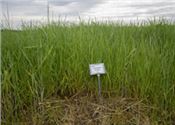|
Cover Crops Present Challenges, Advantages

This test plot at Mississippi State University’s Delta Research and Extension Center in Stoneville was planted
in vetch and allowed to grow over the winter before the cash crop is planted in the spring.
File photo by MSU Extension Service/Kevin Hudson
STARKVILLE, MISS.
Producers who plant winter crops with no intention of harvesting them reap the benefits of soil conservation, weed control and nutrient retention.
On the flip side, however, the practice of almost constant production in a field creates issues with pest management. Farmers who “plant green” have to balance these challenges to best prepare the way for good crops each year.
A half-day symposium on cover crops and planting green kicked off the Mississippi State University Extension Service 2017 Row Crops Short Course in December. This annual event draws more than 650 farmers, crop consultants, industry professionals, Extension agents and researchers to hear the latest information on crop-related topics.
Farmers have used cover crops for millennia to control erosion and add nutrients back into the soil. According to the Journal of Soil and Water Conservation, George Washington, the first U.S. president and a prominent farmer, heavily promoted the use of cover crops to replenish the soil.
The practice continues today for the same reasons, but the recent spread of herbicide-resistant weeds has brought increased interest in these crops as a management tool.
Darrin Dodds, Extension cotton specialist, said cover crops can maintain or improve water infiltration, as well as soil structure and microbial populations.
“Cover crops also may be beneficial for weed control. Improved weed control may be achieved by planting cover crops and then terminating them and allowing the cover crop residue to act as a barrier to weed emergence,” Dodds said. “Some cover crop species produce allelochemicals, which are chemicals secreted from plant roots into the soil that provide some level of weed control.”
While cover crops have a known degree of usefulness, their use can be controversial.
“Cover crop use must be more than a return on investment idea,” Dodds said. “It can be difficult to place a monetary value on such things as soil improvements or weed control through the use of cover crops. Their cost also must be factored into a crop budget.
“Their controversy may come from the abundance of information given by an array of sources,” he said. “Many folks promote benefits that may or may not be backed by scientific research.”
Don Cook, a research entomologist with the Mississippi Agricultural and Forestry Experiment Station, discussed the effect of cover crops on early-season pest management, specifically in corn and soybeans.
“Not all cover crops are the same when it comes to the risk potential for insects, and we can put ourselves into some pretty ugly situations when planting crops while insects are still in cover crops,” Cook said.
He said soybeans can compensate much better than corn when there is insect damage during stand establishment.
From an entomological perspective, Cook recommended avoiding a “green bridge,” or having green vegetation in the field when a cash crop is planted
“Our recommendation is to have all vegetation – winter weeds or a planted cover crop – completely killed at least three weeks prior to planting,” Cook said.
“When you have a green bridge or plant green, soil insects have a live plant to feed on all the time, and insects that may infest the crop later can use the cover crop to build populations,” he said.
Larry Steckel, a plant sciences professor at the University of Tennessee, spoke on several aspects of cover crop use.
“We have a concept that we’re trying to dial in. Growers can adopt cover crops to meet a need,” he said. “The goal of cover crops is to control winter weeds, and they can help in the battle against herbicide-resistant weeds.”
Steckel said a balance must be found in growing the correct mix of cover crops, terminating that crop at the right time and treating for insect pests that use the crop as food. When handled correctly, cover crops can replenish soil nutrients, limit erosion and battle against herbicide-resistant weeds. ∆
|
|